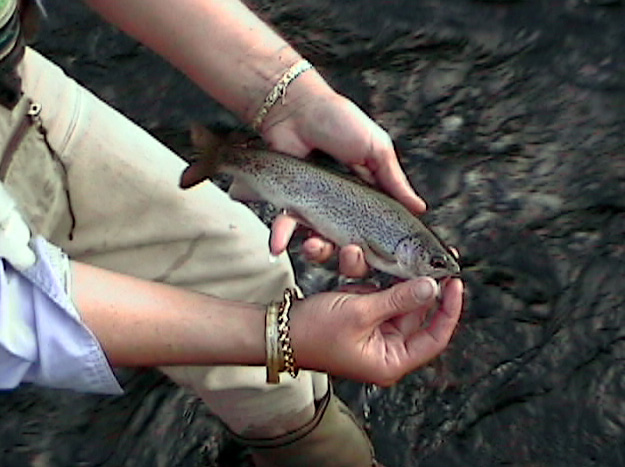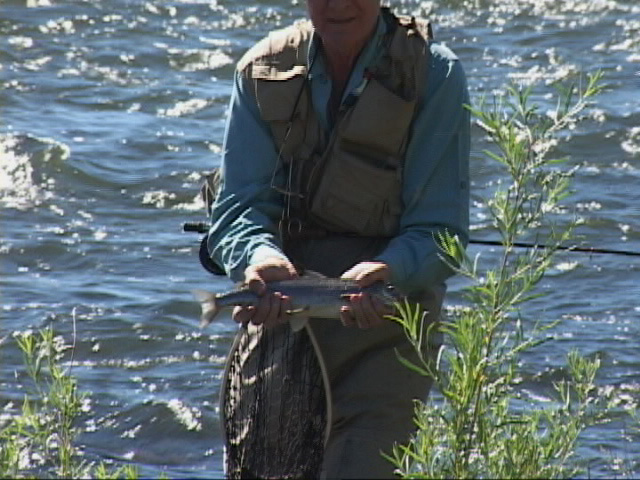
summer, look for them in the
highly oxygenated water such
as plunges, riffles, below water
falls and cascades and swift
runs.
Summertime is the main season in Yellowstone National Park. Fly fishing greatly depends on water heights and temperature. Mid Summer usually means low and warm water. Hopefully, melting snow and thunderstorms will provide enough water to keep the streams reasonably full and that drought conditions are not experienced. The lower elevation streams depend greatly on the amount of annual snowfall as well as rain. This varies considerably from year to year.
Weather:
The daytime temperatures during the summer can range from the high thirties in the early mornings to the high nineties during the afternoons. The air temperature can vary quite a bit from the lower elevations to the higher elevations. The cool nights of the higher elevations of the park is what keeps the freestone streams water temperature low enough to sustain very good trout fishing.
Water Levels:
Water levels can become extremely low during periods of drought. Normally, the higher than normal amounts of rainfall keep the streams flowing well enough that the trout can survive. If a certain area of the park happens to get a heavy thunderstorm that drops a lot of water, then the streams within that drainage area may rise for a day or two. They usually never stay very high for long however. After they have been higher than normal for a day or two, the fish usually become very active.
Water Temperatures:
When the temperature of water gets warm it brings on another problem for the cold blooded trout. They must adjust to survive in water with less oxygen. The temperature and the oxygen content of the water are inversely proportional. That means that warmer water holds less oxygen than cold water but for every added degree of temperature there becomes a decreasingly proportional amount of oxygen. The difference in the dissolved oxygen content of the water with temperatures of 70 degrees F., and 75 degrees F., just for example, is substantial.
The water temperatures in the lower elevations of the park on certain streams can become too warm for the trout if there is a long period of extremely hot weather. During this time the water temperatures may reach the low seventies. This makes it tough on the trout and they can even become lethargic. They feed very little if any during these times. Under these conditions the fish should not be caught anyway. The added stress of the fight is not good for them. Anglers should fish the higher elevations of park. It also helps to fish the more oxygenated areas of water or tiny water falls, plunges and narrow runs. The rainbow trout will seek out these area because of the extra dissolved oxygen the turbulent water adds.
During these periods of time, the tree limbs we complain about when they catch our fly, saves the trout. Without the shade they provide the streams would become too warm for the trout even at the higher elevations. Cool rain water and cool nights in the higher elevations usually keeps the water cool enough for most of the trout to survive during these harsh times.
Anglers should also fish much earlier and later than they normally do. The water is a little cooler early in the mornings. Keep your thermometer handy during the summer. If the water temperature is over 68 degrees F., we suggest you move to a different area and look for cooler water.
Hatches:
Check the hatch charts for the Summer hatches. Mid Summer hatches are not quite as plentiful as they are in the Spring and early Summertime but some of them extend on into the mid-summer months. A few other species begin hatching during the summer.
Golden Stoneflies:
The Golden Stonefly, Perlidae family species, hatch during the months of late June, July and August. It is possible that you may find some of these stoneflies depositing their eggs in the late afternoon but shouldn’t be expected. Normally this occurs during the evening. The nymph and adult can be important but the nymph is the main stage to imitate. Like all stoneflies they crawl out of the water to hatch. These larger stoneflies are usually a hook size 8 or 10 but that can vary depending on the exact species.
PMDs:
The PMD or Pale Morning Duns will probably be the most common hatch during the summer months. Be prepared to fish all stages of this hatch.
Flavs:
Small Western Green Drakes or Flavs will hatch for a short time on many streams in the park.
Green Drakes:
The large Western Green Drakes bring trout to the surface in many of the park’s streams. The dun is the most important stage of this hatch.
Pale Evening Duns:
The Pale Evening Dun hatches may still be occurring in some streams the first part of June.
Green Sedges:
Rhyacophila species known as Green Sedges will hatch during the early summer months. The green rock worm is the most important stage to imitate.
Spotted Sedges:
You will find the net-spinning caddisflies that hatch throughout the Summer on all of the streams in the park. These are the Hydropsyche species called Spotted Sedges. They are by far the most plentiful species of caddisfly.
Little Sister Caddis (Little Olive Sedge):
Cheumatopsyche or Little Sister Sedges also hatch during the summer on most streams in the park.
Salmonflies:
The Salmonflies or large stoneflies hatch on some streams in the park. These hatches may continue into the summer depending on the stream.
Little Yellow Stoneflies:
The Little Yellow Stoneflies, or Perlodidae family species, hatch during the summer. Most of them hatch during the late afternoons and evenings and deposit their eggs starting just before dark and into the evening. These range in hook size depending on the particular species. Look for them in the early part of Summer and again in late Summer.
Flying Ants:
Flying ants may appear on some streams during the month of August. Don’t hold your breath waiting on them because your chances of seeing flying ants are slim. Just be prepared just in case because the trout will definitely feed on them.
Ants:
There are plenty of ants around the streams and they sometimes get into the water, especially after heavy rains. Be prepared with both brown and black patterns.
Aquatic Beetles:
Aquatic beetles are in all of the streams in the park. They are usually not prolific in the fast pocket water. There are numerous species and all sizes and colors of them.
Terrestrial Beetles:
Terrestrial beetles are also very prevalent in the park. Make sure you give them a try. There is a tremendous variety of them.
Grasshoppers:
Grasshoppers can be numerous in areas that have a lot of grass along the banks of the stream. Most of the meadow streams have huge numbers of grasshoppers. It doesn’t take grass for a grasshopper to survive but we have never seen any large quantities of them where there was no grass. They come in all sizes and colors.
Copyright 2012 James Marsh

